





Being a veterinarian and a pet owner I sometimes have a different perspective when it comes to battling garden insects as many of the toxins we use to casually use in our garden can be potentially quite hazardous to ours pets. I see a lot of poisoning cases in the veterinary emergeny room, most from toxins meant for rodents or bugs. This article is an attempt to familiarize the reader with some of the more common dangerous and less dangerous insecticides available for use to the general public.
Though not every garden may have rodents, or even snails for that matter, just about every garden is ‘plagued' with insects and spiders the gardener would rather not be there. There is an impressive array of poisons and substances created for the ongoing battle against the smaller forces of nature. This is a huge category of toxins and there is no way I will be able to cover them all in this article. Some of the more common and dangerous ones will be discussed, however.
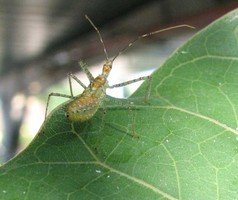
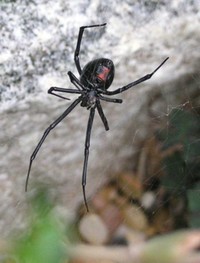
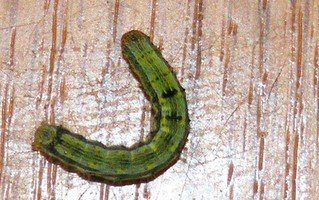
While we may want to rid our garden of these...
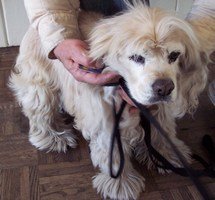 We have to protect our innocent friends and family members who trust us to keep them safe
We have to protect our innocent friends and family members who trust us to keep them safe
A recent trip to the local nursery and garden outlet center introduced me to a number of toxins used to control bugs- some old familiar ones, along with a few newer ones. It never ceases to amaze me the tremendous number of products we humans use to battle nature. There must be a huge demand or the chemical companies wouldn't keep cranking out these toxins. Fortunately there seems to be a concerted effort to formulate effective products that kill bugs but do not kill us or our pets as easily.
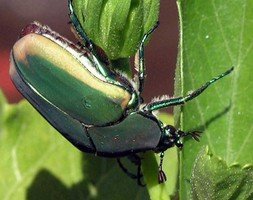
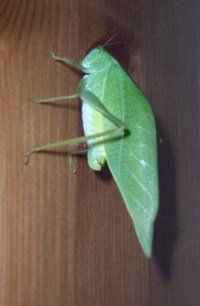 Pests are everywhere in the garden
Pests are everywhere in the garden
The organophosphates: This is probably the largest, most common and one of the most toxic group of insecticides on the market. Some of the organophosphates one might encounter when reading labels are Malathion, Disolfoton, Acefate, Chlorpyrifos, Dimethoate, Fenthion, Diazanon, Trichlorfon, Ronnel and many dozens more (see this site for a more complete list: http://npic.orst.edu/RMPP/rmpp_ch4.pdf) . Not all organophosphates have been created equally, with some being incredibly hazardous while others having a very low-level toxicity rating. However all are potentially toxic and even deadly in sufficient doses. These are readily absorbed through skin and breathing as well as ingestion, so pets don't have to gobble these ones up to get poisoned by them. I have seen many cases of organophosphate toxicity over the years, but they are less common now than before thanks to the use of so many of the other newer and less toxic insecticides. Most dogs are poisoned by ingestion from products that contain both organophosphates along with a fertilizer (it's the fertilizers that attract the dog's attention as they often contain smelly or yummy items- few dogs develop a liking to organophosphates themselves). Disolfoton often gets into dogs this way and is probably one of the more deadly of the organophosphates taking less than a tsp of product in a 55lb dog to cause death. This is a very common product used for treating roses.
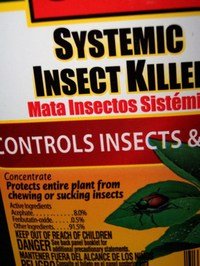
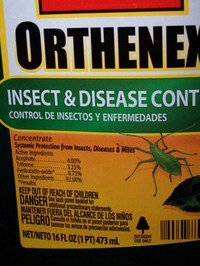
Two products containing Acephate, an Organophosphate, and Fenbutanin, something called an Organometallic which seems to have minimal toxicity to mammals or birds (it's an acarcide, or kills mites), but is highly toxic to fish
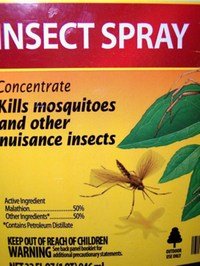
Malathion product
Organophosphates are effective insect killers, but are not very selective, killing just about any creatures they come in contact with, depending on how much each creature is exposed to. These poisons, when eaten by pets, initially cause excessive salivation, tearing, panting... then vomiting and diarrhea (often with blood)... and finally muscle tremors, seizures, coma and death. The first few symptoms are pretty non-specific, but suggestive of organophosphate (OP) poisoning , but as each new symptom appears the diagnosis becomes a bit more clear. Still, dogs that come in with OP toxicity can be difficult to diagnose accurately without a history of having eating these poisons, delaying proper treatment. Many other poisons can cause all these symptoms. There are tests that can be run to diagnose this poisoning, but they take days to run, and most of these pets don't have days. For that reason, pets with OP poisoning can often be treated improperly and die eventually, despite veterinary care. There are a few antidotes for this poisoning which can save the life of a pet when given early enough in the treatment. If you use these products and your pet gets ill with any of the above symptoms, you need to tell your veterinarian that OP exposure is a possibility.
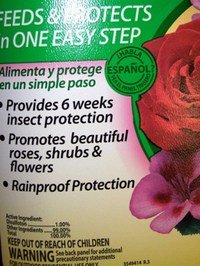
Disulfoton Rose product... this is one of most toxic of the Organophosphates
Fortunately Organophosphates are used far less frequently, and the super toxic ones are not as commonly used anymore (except for disolfoton). Malathion is still used a lot and this was the product dumped out of helicopters all over California neighborhoods in an effort to kill off the Mediterranean Fruit Fly in the 80s. Fortunately Malathion is not one of the more toxic OPs, but it is an effective bee killer. Bees are on a rapid decline all over the US and it may be no wonder, as these toxins build up in the environment.
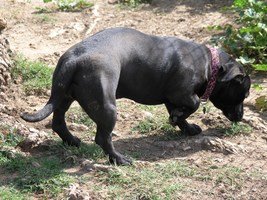 Dogs will seek out organophosphate products when mixed with tasty fertilizers and bone meal
Dogs will seek out organophosphate products when mixed with tasty fertilizers and bone meal
Carbamates, notably Carbaryl, is a group of toxins having very similar effects on insects to organophosphates, and causes very similar symptoms in our poisoned pets. Fortunately Carbaryl is not one of the more toxic carbamates and is the product in a very common over-the-counter (OTC) product called Sevin, which is used for just about anything that involves killing little bugs. For some reason birds are particularly resistant to carbamates, so Carbaryl is actually used as a relatively safe poultry dust for mites, flies and ticks (safe to the poultry at least). The primary antidote for OP poisoning, 2-PAM, does not work for carbamate poisoning unfortunately, but still there are products that can reverse some of the symptoms or toxicity of these products. Cats are especially susceptible to carbamate toxicity, so if you own a garden cat, you might want to avoid these products. Most cats that get poisoned with carbamates are inadvertently exposed to canine anti-flea products containing these poisons, but still, use caution with this product in the garden.
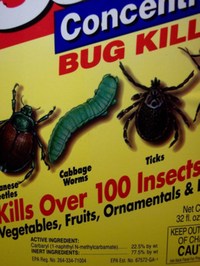
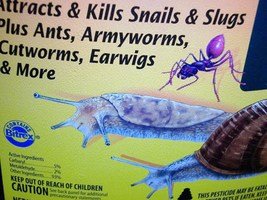
Carbaryl product commonly used in back yards, and a combo product also containing metaldeyhyde (see Snail toxin article)
Organochlorines such as Lindane and Methoxychlor have been used as pesticides for many years, but because of their incredible slow breakdown in the environment, their use is finally thankfully curtailed. Pets that get into these products can show gastrointestinal symptoms (vomiting, diarrhea and abdominal pain) when then progress on to neurological symptoms (tremors, seizures, coma). These toxins are particularly well absorbed right through the skin, so toxicity doesn't always have to be from ingestion. There is no antidote at all for these poisons. Best just not to use them for any reason.
One of the ‘natural' pesticides frequently used in garden products are the pyrethrins, Chrysanthemum extracts. These products are much safer for your pets, relative to the above 3 garden toxins at least. Pyrethrins are broken down almost immediately once ingested so oral poisoning is rare in pets. However this product is very effectively absorbed through the skin (used as a canine flea product for that reason) and much higher blood levels can then be reached. In dogs pyrethrins may cause very temporary allergic reactions and mild neurologic problems, but the products are highly toxic to cats. Be very careful when using anything with pyrethrin around the garden if you have cats out there, despite the claims these products are ‘safe' for use. And of course NEVER use pyrethrin products directly on your cats, or even on your dog if you have cats that like to cuddle with them.

Pyrethrin product sold as a 'Safer' product for use in the yard
Pyrethroids are synthetic pyrethrins and are probably the most commonly sold OTC pesticides one sees on the shelves today. These have an advantage of being even a bit less toxic than pyrethrins (still toxic to cats, though!) and less insect resistance. There are dozens of pyrethroids on market now (presumably in an attempt to stay a bit ahead of the insect resistance problem). Just about any poison that ends in ‘thrin' is a pyrethroid (eg. Permethrin, Bifenthrin, Cyfluthrin, Resmethrin etc.). Esfenvarerate and fenvarelate are about the only pyrethroids that don't follow that rule. Both are used in common garden pesticide formulations as well. Fortunately most pyrethroids are not that easily absorbed through the skin as are pyrethrins. Still, excessive exposure to these products by cats will result in poisonings, with the primary symptoms being uncontrolled muscle tremors and seizures. And both pyrethrins and pyrethroids are highly toxic to both birds and fish. Pet birds have a particularly efficient respiratory system that unfortunately works against them when exposed to aerosolized formulations of these products, and they can be make them quite ill (neurologically) or kill them. There are no antidotes for either pyrethrins or pyrethroids, but most animals will recover with symptomatic treatment and supportive care. But still use these products with caution!
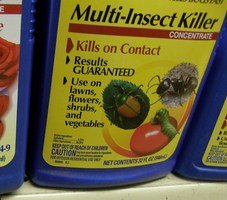
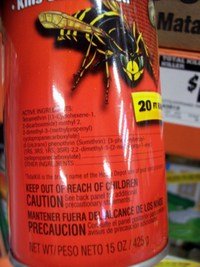
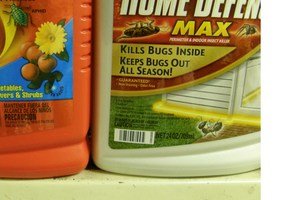
Cyfluthrin Tetramethrin and Phenothrin Bifenthrin (thought this was supposed to hard to find, but here it is)
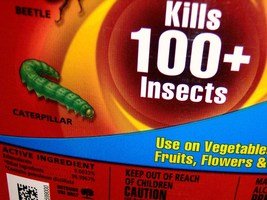 Esfenvalerate, one of the few non-'thrin' pyrethroids
Esfenvalerate, one of the few non-'thrin' pyrethroids
If one is reading labels, one might notice products containing pyrethrums (meaning pyrethrins and pyrethroids) also have something called Piperonyl butoxide in them. This is known as a synergist which makes the pyrethrums all that more toxic to the insects (and you and your pets unfortunately). Piperonyl butoxide affects the mammalian liver by keeping the liver from detoxifying these products (and any other poison one might come in contact with for that matter). So products containing this synergist are even more dangerous to your pets, so careful!
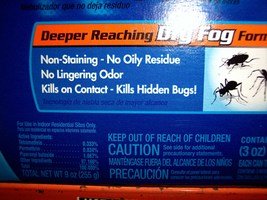
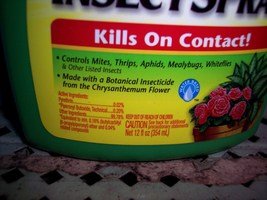
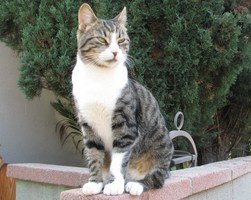
Tetramethrin, Permethrin and Piperonyl Butoxide Pyrethrin and Piperonyl Butoxide product These products are exceptionally toxic to cats
All these pyrethrums are highly toxic to bees as well, and that should also be a consideration (though perhaps not the point of this article).
DEET: this product is most commonly associated with insect repellents (mosquitoe sprays etc.) and is often applied in an aerosol fashion. It is often sold as a toxin that is ‘safe' for use on humans. It is also found in a number of garden pesticides, often in combination with pyrethrums. It is not, however, non-toxic, and dogs and cats are much more sensitive to the toxic properties of this poison. DEET is readily absorbed through the oral mucosa, respiratory tract and even the skin for that matter. Additionally, it allows other toxins to be transported readily through skin that might not so easily be absorbed that route otherwise. DEET poisoning in pets starts with drooling, vomiting and diarrhea, followed by tremors, coma and death (if enough is absorbed). Sound familiar? Seems most insecticide toxicities have very similar symptoms in our pets, making them very difficult to tell apart and treat appropriately. There is no antidote for DEET poisoning and all animals are treated symptomatically. Fortunately few deaths occur from this product, presumably as most dogs and cats don't come in contact with enough to kill them. But NEVER use mosquito repellents containing DEET on your pets or you could cause a fatal poisoning.
Arsenic: This is a poison that is so nonselective that it kills not only animal life, but plant life as well. It is used as an insecticide, rodenticide, slug and snail poison, herbicide, antifungal and even a wood preservative. This is toxic stuff! Yet it is a commonly used pesticide both around the house and outdoors in anti-ant and cockroach preparations. Thankfully insects seem more susceptible to small amounts than are pets (size has something to do with that) so most insect traps contain very little arsenic in them and a dog would have to eat a number of them to get a toxic dose. Dogs can also be exposed by chewing/eating treated lumber. But arsenic has long term effects as well as short term, so just because a pet was not affected with a single dose does not repeated exposure will not cause a problem.
There is very few things that arsenic does not affect. It can cause skin irritation if contacted, and respiratory irritation if breathed in. Orally, it can cause severe gastrointestinal symptoms and pain, often resulting bloody diarrhea and vomiting. Neurologic signs are also possible with the usual pesticide symptoms of tremoring, seizures and coma. Liver damage can occur. Blood cells can be affected causing anemia and inability to mount an immune response to infection. Circulatory collapse can result (heart attack). It affects every and all parts of the body. Best to avoid arsenic if you have a pet (and this product is equally toxic to the gardener as well, so maybe best to avoid anyway, even if there are no pets around).
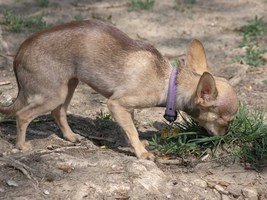
though perhaps not terribly dangerous to a large dog, a 3lb chihuahua can easily be severely poisoned with these products
d-Limonene: This is a natural product made from citrus extracts and used in canine flea products and in garden pesticide products. Though apparently fairly non-toxic to dogs, this can extremely toxic to cats and should not be used in one's garden should one own a cat. I have personally seen several severe toxicities with this poison when inadvertently used on cats (used to sold as a 'safe and natural' product for both cats and dogs originally, but then the toxicity problem in cat was uncovered). It is an excellent example of a 'natural' but highly toxic pesticide.
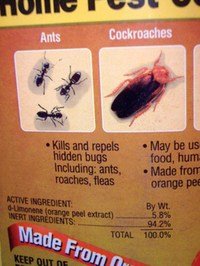 d-Limonene insecticide
d-Limonene insecticide 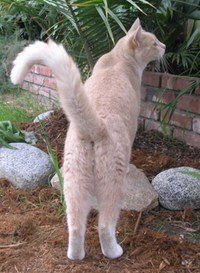 BAD for cats!
BAD for cats!
Rotenone: I have used this product on animals for certain topical infestations, but in minute amounts. As a garden pesticide it seems to have pretty low toxicity and I have yet to hear of a problem with this product in terms of pets. But it is quite toxic to all insects. For some reason it is not used much in over the counter products, so there may be some effectiveness issue, but toxicity does not appear to be a big problem.
Sabadilla is a 'natural' Lily extract product that does have some very irritating properties when contacting the mucous membranes. Though I had not even heard of this product nor any toxicity problems with it otherwise, it does not appear to be a popular one for some reason.
Borates/Borax are fairly safe insecticides unless large quantities are breathed in. Serious pulmonary inflammation can result if the dust is breathed, so this must be kept in mind if one is using this product in the garden. It is an effective insect desiccant (more so indoors than out, though) but not a very common pesticide for garden use.
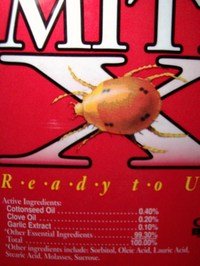
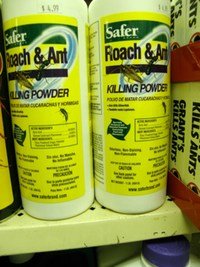
Borax product for ants Boric Acid product with a Cockroach hormone to attract them
Garlic Oils can be commonly found on nursery shelves as ‘natural' insecticides and touted as safe for use around the garden. I don't know how such products are used exactly, but garlic is far from safe as far as dogs and cats are concerned, and I would advise using such products very cautiously. Pets have an exceptional sensitivity to the toxic principles of garlic and onions and acute ingestion can result in very serious anemia as well as gastrointestinal upset. Prolonged exposure can lead to permanent gastrointestinal and liver damage in dogs and cats. Sometimes ‘natural' does not guarantee safety!

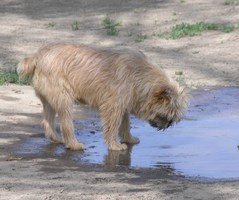
though the cottonseed and clove oils may be safe for ones pets, I could not say the same for the garlic in this product. Many products may be safe in miniscule amounts, but garlic tastes good, and can be concentrated in pools after rain, so caution!
Imdacloprid is a product that has been used in the veterinary world as well as a safe and effective flea product so I am more familiar with this chemical than some of the others in this article. I do not know how effective it is in the garden, but it has been used agriculturally for decades with some apparent success. This is one of the few insecticides that has very little if any toxicity to mammals or birds. It is moderately toxic to fish but highly toxic to bees. However, from a veterinary perspective, this is one of my favorite pesticides due to its safety to dogs and cats.
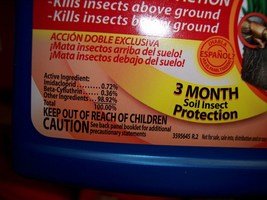
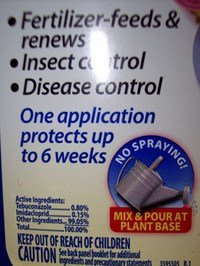
Products with Imdacloprid- first one also contains a pyrethroid (Cyflurthrin) while the second an antifungal
Fipronil is also used in veterinary flea products, and it, too seems relatively non-toxic to dogs and cats, though it has some curious effects on rabbits and should NOT be used around them. It is also highly toxic to fish, and reptiles. Its danger to birds is variable with some species being very sensitive to it and others being totally unaffected by it. Still, it is a relatively effective product with little danger to most mammalian pets. If you have a garden bird, fish or rabbits, this is not a product you want to use carelessly. Mode of toxicity is not well understood in these animals, with some dying and others seemingly unaffected.
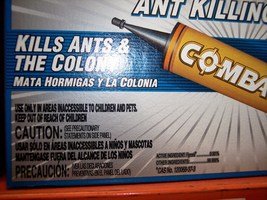 Product containing Fipronil
Product containing Fipronil
Neem Oil seems to be another relatively same garden pesticide, toxic only in very large doses. Smaller amounts can cause skin irritation to susceptible individuals, but I have never seen a case of neem oil toxicity or even skin irritation. Perusing the internet one might even consider this a miracle product as it is used to heal all sorts of maladies as well as being a fairly good insecticide.
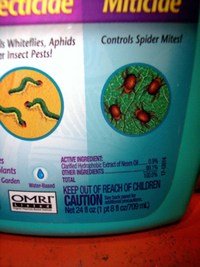
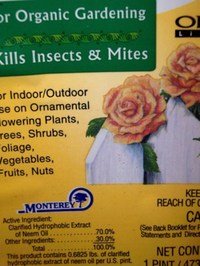
Several of many insecticide products made from Neem Oil
Other Oils: Herbal oils, Cinnamon oil, Jojoba oil, Soybean oil, Sesame oil, Cottonseed oil, Castor oil, Parrafinic oil, Petroleum oils, Cedarwood oil and Citronella oils are in a few garden insect products and most are rated as fairly safe. I have no idea how effective they all are, but I could find no instances of pet poisoning with these products.
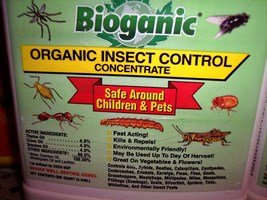
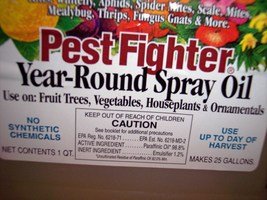
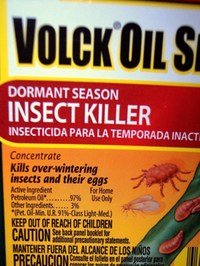
this product contains three different plant oils The active ingredient is paraffinic oil product containing petroleum oil
Potassium salts: Insecticidal soaps usually contain this product and though only seemingly effective if applied directly to the insects, this does seem to be a very safe product around pets, with no reports of toxicity that I could uncover
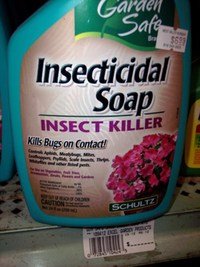
Bacillus thuringiensis- there are several insecticidal products sold with live cultures of this bacteria in them under the 'environmentally safe' banner and though indeed these products seem very 'safe' to use when compared to most pesticides they do not appear to be 100% safe showing some ability to kill fish, cause infections in people and indescriminate toxicity to beneficial insects. However I could find no studies about pet toxicity. Effectiveness of such products are questionable, though.
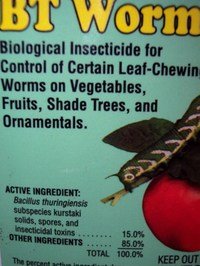 live bacterial product
live bacterial product
In my search for other insecticides I came across a few I was not familiar with. Reading about them I was surprised to find no pet toxicity information on any of them, and all were being touted as being ‘safe', at least relative to the above pesticide products. That may indeed be the case, but many toxic properties take years to discover, so be careful anyway if using one of these products. They may turn out to be toxic but we may not discover the actual toxic principles for some time now until their use is so prevalent pets will be exposed in large enough numbers to ferret out these toxic properties.
Indoxacarb is one of these newer toxins. It is an effective insecticide but is supposedly only minimally toxic to mammals. It has moderate bird toxicity but is very toxic to fish. (Note: see comment below by Hammishdad... perhaps not so safe afterall) Spinosad is another fairly new insecticide that just came as an oral flea product for dogs so it's safety, at least in dogs, seems to be excellent- the garden insecticide Spinosad has recently shown up on a few shelves in local nurseries. It is a natural bacterial fermentation product that is effective against a few garden pets, but not very toxic to much of anything else, including bees. There is virtually not data on pet toxicity I could find.
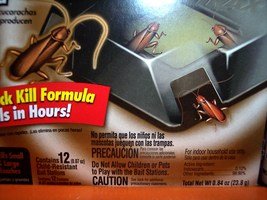
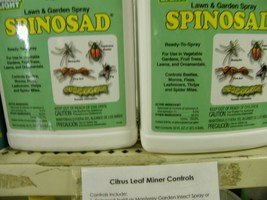
Two newer and relatively 'safe' insecticidal products: Indoxacarb on the left 'maybe safe' and Spinosad on the right certaintly seems so
The battle against garden insects will be one few gardeners will ever win, but at least there are products available that seem much safer than others. Gardeners that also own pets should do some research and thorough searches about their local nurseries and garden centers in search of some of these safer products, and try hard to avoid using the dangerous ones. Unnecessary use of toxic products around one's pets can lead to serious or fatal consequences.
 please think about your pets before killing your pests
please think about your pets before killing your pests
Copyright © www.100flowers.win Botanic Garden All Rights Reserved